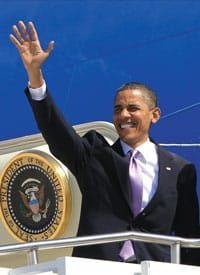
ITEM: Writing in the Washington Post for May 28, the “chair” of the White House Council of Economic Advisers, Christina Romer, called for passage of a $23 billion “emergency spending bill.” The legislation before the House, she said, “would address the education crisis facing communities across America — and the jobs of hundreds of thousands of teachers are at stake. Because of continued high unemployment, state and local budgets are stressed to the breaking point. Many states and localities are drastically cutting education spending.”
By “preventing layoffs,” she argued, “we would save on unemployment insurance payments, food stamps and COBRA subsidies for health insurance, and we would maintain tax revenue.”
ITEM: “As many as 40 states,” reported Bloomberg Businessweek for June 4, “may adopt U.S. academic standards proposed by the nation’s governors and school chiefs, culminating a two-decade push for consensus on what U.S. schoolchildren should learn for college and work…. President Barack Obama’s administration supports the state-led movement to adopt national standards to replace the hodge-podge of curricula now in place. Business leaders and government officials are applauding the effort because of concern that countries with rigorous guidelines are outperforming U.S. schoolchildren on international assessments and the attainment of higher education.”
CORRECTION: If an extortionist tries to get you to agree to a deal by offering you some of your own money, but only if you meet certain conditions, you’d be well advised to see a lawyer first. If that lawyer approves, you should get another lawyer. However, in Washington, such extortionists are sometimes called Education Secretaries or White House economists.
Sometimes they claim to support local education and promise that federal funding will bring about wondrous results but not lead to federal controls. That’s palpably untrue, but those willing to engage in what amounts to sanctioned bribery are hardly going to be put off by a falsehood here or there.
The generous folks in Washington apparently just can’t spend our money fast enough. When the Obama administration pressed for $23 billion in “emergency” education spending in late May and early June, there were still tens of billions of unspent dollars left from the $100 billion earmarked for education in the so-called 2009 stimulus package. That was also dubbed an emergency.
It is entirely possible that without a bailout some education jobs would be lost, which is no small matter to the people involved. However, the union-heavy, Democrat-beholden sector has been riding high for a long time, with a huge expansion of staff — quite apart from teachers — plus smaller class sizes and larger salaries. Nevertheless, there has been little to nothing commensurate noted in the performance of their product.
Yet, if there’s one bit of math that education union bosses can understand, it involves the number of teachers compared to the number of students. The lower the ratio, the more teachers are needed. More teachers = larger slush funds for union coffers. Those monies are then used to buy votes from politicians for more boondoggles for their allies. In the U.S. public schools in 1950, there were 27.5 students for each teacher. That number plummeted to 15.5 students per teacher by 2006. Does anyone think the students are learning anything close to twice as much?
Moreover, as noted by E.J. McMahon of the Empire Center for New York State Policy
While class size reduction is a perennial priority of teacher unions, education research indicates that class sizes have little if any impact on pupil performance. Even small reductions in class size are extremely costly; for example, at current enrollment levels, reducing the statewide pupil-teacher ratio by a single pupil would require the hiring of more than 17,500 additional teachers at a cost of roughly $1 billion.
Meanwhile, the hiring of non-teaching staff in the public schools has been far outstripping student growth. Since 1970, according to Lindsey Burke of the Heritage Foundation, “student enrollment in public elementary and secondary schools has increased just 7 percent, while public elementary and secondary staff hires have increased 83 percent.” As she noted, “In the mid-20th century, public schools employed 2.36 teachers for every non-teacher on their rolls; today, the ratio is closer to one to one.”
And many teachers make a good living. Consider the teachers in Seattle, for example. According to a study by the Washington Policy Center: Teachers in Seattle receive an average of $70,850 for a 10-month year, plus $9,855 in benefits. Teachers can earn up to $88,463, or $98,318 including benefits. Educational staff associates are paid an average of $76,339 for a 10-month year, or $86,194 including benefits.
It is mandatory for teachers to pay union dues or an equivalent. Seattle District officials transfer about $290,000 per month in education funds to union accounts in the form of dues. Over the course of a year, about $3.2 million is forwarded to the Seattle teachers’ union.
Also, those who are beating the emergency drum the loudest about teacher layoffs are plainly exaggerating. Crunching the numbers being tossed around by the American Association of School Administrators, Neal McCluskey finds that the worst-case scenario would be a 4.4 percent cut; the low end of the estimate by Secretary Duncan would be a 1.6 percent trim. “That’s less than one out of every 60 public-school jobs,” he writes in the New York Post. “Moreover, the projected cuts would be but a tiny step back after decades of spending and staffing leaps.” Is the public sector supposed to be immune to the recession caused, in large part, by a gusher of spending on the public sector?
Even the left-wing Washington Post couldn’t swallow all of this. As the Post editorialized, it’s almost certain that 300,000 won’t lose their jobs. Continued the paper on May 28:
For technical reasons, school districts must send notices in the spring to more teachers than they actually expect to let go in the fall. What’s more, the unions’ 300,000 estimate includes not only classroom teachers in kindergarten through 12th grade but also support staff and college professors. The bill would distribute money to states according to their population, not expected layoffs; states where no layoffs are imminent would get checks anyway, and the majority of states would receive more than they could possibly need to avoid layoffs. The Senate version of the bill permits them to spend the excess on other things.
Meanwhile, the lack of national standards, maintain many proponents, is what has been holding back student performance, especially when compared to other countries that do have national standards. Hardly.
There is “no empirical evidence that national standards produce superior educational outcomes,” points out McCluskey, associate director of the Cato Institute’s Center for Educational Freedom. He examined in detail how the evidence has been deceitfully cherry-picked in an attempt to buttress the case for national standards.
For instance: “It is true that most nations that have outperformed the United States on such tests as the Trends in International Mathematics and Science Study and the Program for International Student Assessment have national standards, but so do most nations that have done worse. To illustrate, on the 2007 eighth-grade TIMSS mathematics assessment, the eight countries that outperformed the United States had national standards. But, then, so did 33 of the 39 nations that scored lower. Moreover, 11 of the 12 lowest performers had national standards.” (“Behind the Curtain: Why National Standards Won’t Fix American Education,” Policy Analysis)
The “national standards” movement, write Lindsey Burke and Jennifer Marshall of the Heritage Foundation, seems much more concerned with uniformity than with excellence. “Uniform minimum-competency standards on a national level would provide a one-size-fits-all approach that would likely lead to decreased emphasis on advanced work and a generally dumbed-down curriculum. Centralized standards and testing would eliminate the possibility of competitive pressure for increasing standards of excellence.”
Since 1965, there has been approximately $2 trillion dollars, adjusted for inflation, spent on public education. To be charitable, let’s just say it was hardly worth all that treasure. Yet we are supposed to believe that another $900 million filtered through the Obama administration in education grants, then dished out to those states that fall into line at the trough, will turn around poorly performing schools.
One oft-cited definition of insanity is repeating the same behavior over and over and expecting different results. That’s a truism that should be inscribed on the walls of Congress — where someone would probably have to read it to the lawmakers.
— Photo: AP Images



